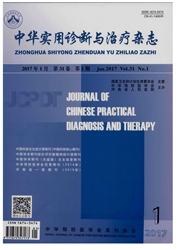

 中文摘要:
中文摘要:
目的:探讨维、汉民族外周血细胞数量及形态变化与冠心病的关系,并比较维、汉民族冠心病患者之间的差异。方法:987例行经皮冠状动脉造影检查者按冠状动脉造影结果分为冠心病组(510例)和对照组(477例)。检测指标选取:粒细胞系(白细胞计数、中性粒细胞计数、淋巴细胞计数、单核细胞计数),红细胞系(红细胞计数、血红蛋白、红细胞压积、平均红细胞体积、平均血红蛋白量、红细胞分布宽度),血小板系(血小板计数、平均血小板体积、血小板压积、血小板分布宽度)。进行同一民族冠心病与对照组的比较及维、汉不同民族冠心病患者之间的比较。结果:汉族冠心病患者白细胞计数、中性粒细胞计数、红细胞计数、血红蛋白和红细胞压积的检测结果与对照组相比差异有统计学意义(P〈0.05),维族冠心病患者白细胞计数、中性粒细胞计数、单核细胞计数、平均红细胞体积、平均血红蛋白量和平均血小板体积检测结果与对照组相比差异有统计学意义(P〈0.05);汉族与维族冠心病患者比较,除血红蛋白外检测结果均有统计学意义(P〈0.05);维、汉民族冠心病患者不同病变程度之间比较,单支和双支病变患者主要表现为粒细胞系和红细胞系的差异,差异有统计学意义(P〈0.05),而在多支病变组则主要表现为红细胞系和血小板系的差异,结果比较差异有统计学意义(P〈0.05)。结论:维、汉民族冠心病患者之间外周血细胞检测结果具有民族差异性,汉族冠心病患者主要表现为炎症和血流动力学方面的改变,而维族则主要表现为炎症和凝血系统的改变。随着病变程度的加重,冠心病患者体内炎症系统、血流动力及凝血系统逐渐被激活,在冠心病的发病机制中具有重要作用。
 英文摘要:
英文摘要:
Objective To investigate the relationship between the quantity and form changes of peripheral blood cell and coronary heart disease in Uygur and Han nationality, and compare the variability between the two nationalities. Methods All the 987 patients underwent coronary angiography and peripheral blood cell counts and were divided into 2 groups according to the results, 510 patients with coronary heart disease and 477 healthy controls. The detection indexes included granulocyte series (white blood cell, neutrophilic granulocyte, lymphocyte, monocyte, erythrocyte series (red blood cell, hemoglobin, hematocrit, mean corpuscular volume, mean corpuscular hemoglobin, mean corpuscular hemoglobin concentration, red cell distribution width), and hrombocyte series (platelet, mean platelet volume, plateletocrit, platelet distribution width). The results were compared between coronary heart disease patients and healthy controls in same nationality, and the difference between the Uygur and Han nationality with coronary heart disease. Results Compared with health controls, the results of white blood cell, neutrophilic granulocyte, red blood cell, hemoglobin and hematocrit in coronary heart disease patients had statistic differences(P〈 0.05) in Han nationality. The results of white blood cell, neutrophilic granuloeyte, monocyte, mean corpuscular volume, mean corpuscular hemoglobin and mean platelet volume in coronary heart disease patients had statistic difference compared with normal controls in Uyger nationality. Compared Han with Uygur nationality, all indexes had statistic differences(P〈0.05) except hemoglobin in patients with coronary heart disease. According to the level of pathological changes between Uygur and Han nationality, in the patients with single and double vessel disease, the significant differences were granulocyte series and erythrocyte series, and were erythrocyte series and hrombocyte series in the patients with multivessel disease. Conclusion The major demonstrations of Han nationality
 同期刊论文项目
同期刊论文项目
 同项目期刊论文
同项目期刊论文
 期刊信息
期刊信息
